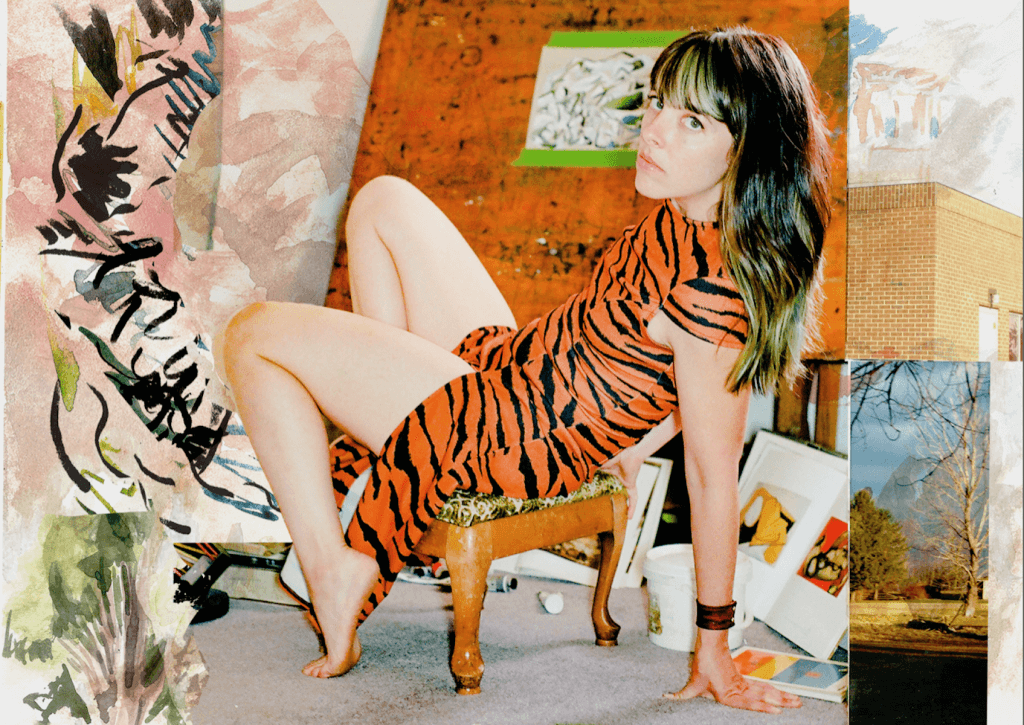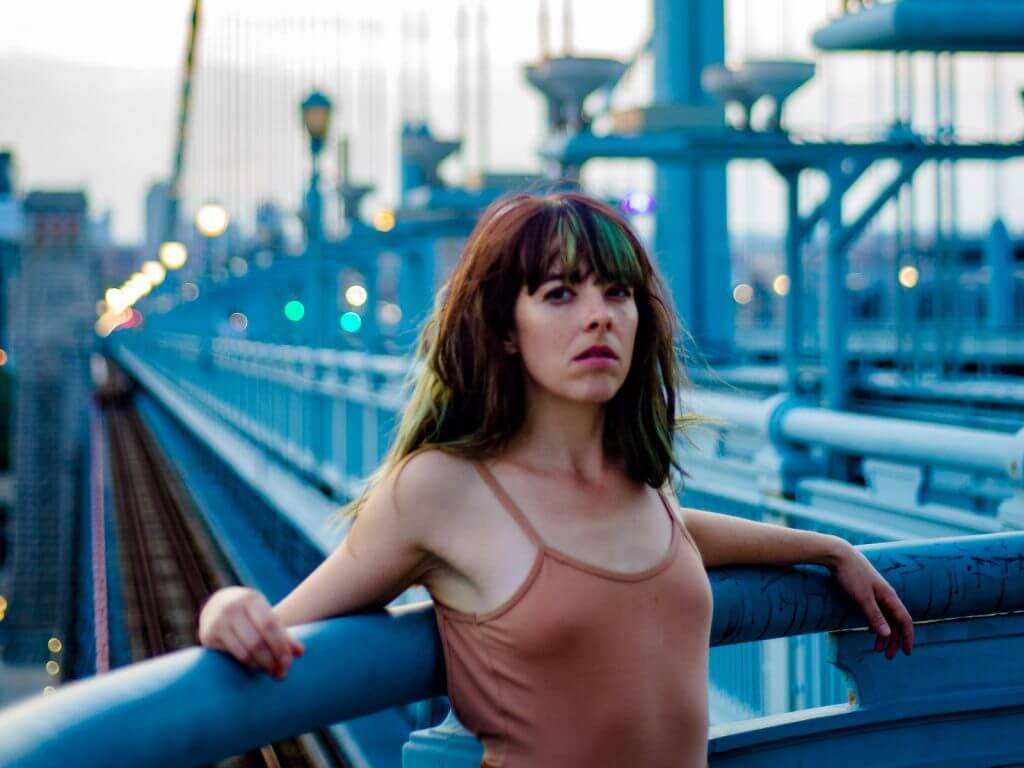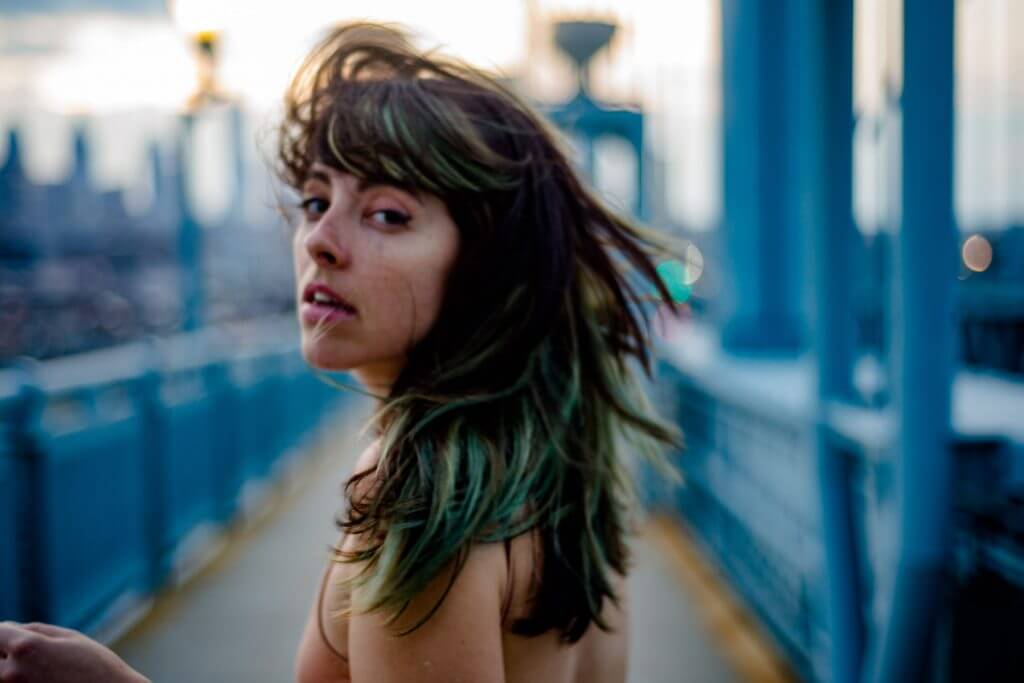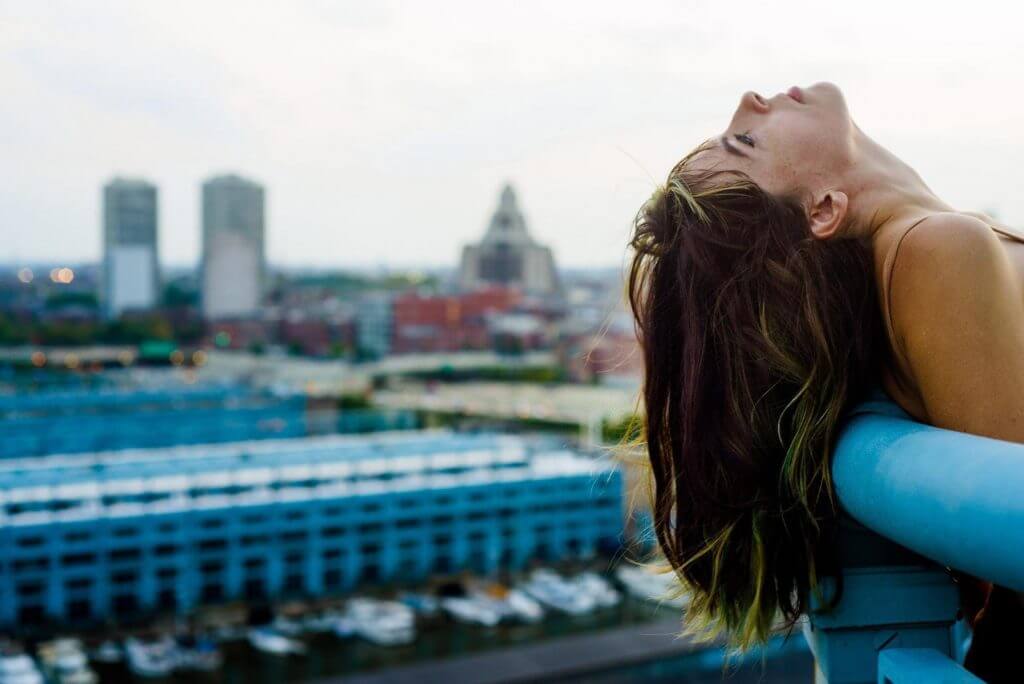Hop Along’s Frances Quinlan: Songwriter, Painter, Traveler

Frances Quinlan is best known as the lead singer and songwriter for Hop Along, one of Philly’s most successful indie rock bands of the 2010s. But before she graced the stage with her band, she started out performing solo under the name “Hop Along, Queen Ansleis.” As she’s toured through the years, she has also often spent time in the van painting or drawing in her journal.
Now, in January 2020, she has gone back to her solo roots with Likewise, released under her given name. Clocking in at just under 35 minutes long, Quinlan’s new record is densely packed with anthropological references, vernacular outtakes from conversations, snarky one-liners, philosophical quandaries, and a whole bevy of different emotions. Although it is a solo album in spirit, Quinlan is often accompanied by at least one other instrumentalist, including Hop Along guitarist Joe Reinhart, who also co-produced the album along with her. Still, sonically Likewise has more bare and simplistic instrumentation than we are used to; because of this, Quinlan’s characteristic vocal style, which jumps around her complex melodies like a pinball and sometimes climaxes in a perfect growl, stands out even more.

FRONTRUNNER met with Quinlan to discuss the foundations of Likewise, as well as her first visual arts show, entitled “Is This The Place?,” which also opened in January 2020. During our conversation, we also learned more about her love for Joni Mitchell, the timeline of her music preferences since adolescence, and the practical and philosophical aspects of painting in a moving van.
What was the motivation to work on a solo album?
I think [when] anyone gets to a point in their career where they’ve kind of found their groove, there’s this natural desire to add some dynamics to that professional life. But this kind of happened accidentally, in some ways. I’ve played solo stuff in the past, and I started out solo a long time ago, so it’s not completely foreign to me. However, in the past, any “solo” song I ever had would just be on a Hop Along record. We have a record called Painted Shut that has a song called “Happy To See Me,” and that is essentially a solo song. There’s sometimes songs that feel pretty complete as they are, with guitar and vocals.
There were two songs that were supposed to be on Bark Your Head Off, Dog, the last Hop Along record, and those songs were “Went To LA” and “A Secret.” Those were recorded in 2017, and I started writing them around 2013. It turned out they made the record 11 songs and, timewise, it made the album too long. It would have had to be a double LP. Realizing that, we were trying to decide on B-sides, and I felt very strongly about all of the songs. I didn’t want any of the band’s songs to become B-sides. I thought they all belonged on that album. There already was a solo song, called “How You Got Your Limp,” that was on that record, so I just talked to everybody and they were super understanding and allowed me to take those two songs. [They had] stayed pretty close to their original form. I mean, Tyler Long of Hop Along played bass and piano on “A Secret,” and Joe [Reinhart] played some slide guitar and some bass on “Went to LA,” but we didn’t arrange them, really, as a group. Once I had those two songs, I knew I wanted to keep working with Joe, who is an incredible producer, player, engineer, mixer–I’m just very fortunate to have a colleague like that–and we went into the studio together to record the rest.
I’m interested that time-wise 11 songs would have been too long. Why exactly is that? A lot of bands put out albums that are an hour or so.
It was more of an economical choice. Generally, I love long records. One of my favorite records is Ys [by Joanna Newsom], which is about an hour, but that is a double LP. For the sake of the quality of sound on an LP, Bark Your Head Off, Dog would’ve had to have been released as a double. And that just gets, unfortunately, rather expensive.

After starting with these two songs, do you think that themes ending up emerging on Likewise? Do you like for there to be themes on an album?
I find it can be a hindrance to insist [on] identities or themes in the songs, but I hope that there wouldn’t be too many non sequiturs. Certainly for Hop Along, I don’t worry too much about consistency as far as narrative. I mean, on a song like “One That Suits Me” [from Bark Your Head Off, Dog] I’m talking about World War I, and on another song it’s about more contemporary issues.
But I think for this record, maybe I was a little closer to a particular frame of mind. It was an easy one. The interior world is easy to get lost in, and I think I allowed myself to get a little more lost in that than I would for an album where it’s more of a collective.
It sounds like it could be empowering to allow yourself to be more self-indulgent or internal.
I guess it’s sort of a line to walk. Certain aspects are indulged, but I wouldn’t want to exclude the outside world. I think that can be a little bit defeating of anything bigger coming out of it, like, any connection. [That’s] what the hope is, I think, making anything: you want it to resonate with someone else.
So you alluded to the fact that you love Joanna Newsom. I’ve also heard that you love Joni Mitchell, who was also a painter in addition to being a songwriter. How has she influenced you?
It would be hard for me to pinpoint the exact ways in which she’s influenced me, because I have loved her [since]… I must have first heard her when I was not even quite a teenager. I remember, of course, “Big Yellow Taxi” being one of the first songs that I loved, and “Chelsea Morning.” Some of her earlier stuff and sunnier work I was really into, when I first heard her. Then when I got to be a teenager, one of my cousins had a copy of Blue in her car and we would listen to that. I remember that hitting me very hard. Actually, one of the first songs of hers that I heard was “A Case of You” because it was on the Practical Magic soundtrack. I saw that movie in theaters when I was in 6th or 7th grade. [That’s] such a killer song.
When I was younger, I couldn’t stand songs like “Help Me”–I thought it was so corny–and now I love it. Court and Spark is one of my favorite albums of hers, and then after that I got into Hissing of Summer Lawns and Hejira. It’s such an incredible thing to come across artists who have so immense a catalog that you can go through chapters of it within your life and find different chapters to connect with.

It’s interesting–I’ve had a similar timeline with Joni’s discography. Blue was my first favorite, and then I’ve kind of had the same growth into Court and Spark and Hissing of Summer Lawns.
I certainly was attracted to angst, as so many of us are in our younger years. Joni had melancholy–she had that down–and [on] Blue, I was absolutely attracted to that aspect. She really is able to dive into [that] interior world. But there is a maturity to her writing that I think I couldn’t really appreciate, necessarily, when I was younger.
It’s similar for me, in a way, to Fleetwood Mac. I couldn’t stand them when I was younger, at least I thought so, and suddenly a few years ago they really clicked for me. And it’s great, because suddenly this door opened to this massive library of beautiful songs. Very smooth, tailored songs. I think I was bored with that when I was younger. I needed immediate emotion. Alanis Morissette clicked immediately, and even Neutral Milk Hotel has an edge to it that I really loved. I loved how strange his voice was. I needed it to be weird, somehow–like in quotes: “weird”–when I was younger.
As an artist who works in different media, how do you choose which medium to work in? Are there times when you think, “This feeling has to come out in a painting,” or “This feeling makes me want to get my guitar”?
Generally it’s more the act of painting that I’m drawn to, rather than like, “I have this idea, do I get it out visually or sonically?” I more so think, “Would I rather be painting, or would I rather be playing the guitar?” And then I’m hoping for ideas. Every once in a while a melody hits me and so I go to the guitar. But I think I’m driven more by satisfaction through an act than I am [by] finding the exact right way to execute [something].
You paint a lot on tour, right?
Yeah, that has more to do with the fact that painting is something that I can do quietly in the van. I tend to go off to myself to write, and so that’s a little harder to do on tour. I write in my journal, but [for] melodies I tend to prefer being stationary somewhere.
But painting is a nice way to a) not be on my phone for six hours when we’re driving those longer distances, and b) to feel a sense of presence in the world. Maybe in songwriting I tend to go more into my head, but in painting, even with abstract work, I do think there’s an act of observation that I feel–a sense of leaving myself, in a way, that gives me a lift. I like that I can be part of the world but step outside of myself a little bit. It gets… I want to be careful when I say “meditative,” because I don’t meditate, and I am certainly ignorant of that practice–but it is calming.
https://www.instagram.com/p/B3ISAXhJWnX/
I do think the opportunity to focus all of your conscious attention on something else can give you a lift.
And perspective! If we don’t have a show in Wyoming and we’re just driving through it, it’s nice to have this visual document for myself of, “I was there,” even though I merely passed through.
So you paint mostly landscapes?
That does tend to be the predominant–yeah. I’ve got some portraits in my journals–some drawings–and of course the album cover [for Likewise] is a portrait in pencil over collage. But with landscapes, even though there is this sense of wanting to document a moment, there’s also the freedom to not be entirely faithful. It’s funny, when I first started painting in the van I would try to be faithful to the moment, but you’re driving so fast there’s no way you’re gonna be able to capture an actual piece of the highway. By the time you get it on the paper, you’ve passed it, so you’re only going by memory. As time passed, I realized that it really doesn’t matter. I also stopped worrying how other people would see them. The more you do something, the more freedom you feel to go outside the lines, I guess.

Album cover art for Likewise (2019)
Tell me about your gallery opening in Chelsea. Was it all new work, or was there anything older?
The oldest piece I had in the show is from 2013 in the summertime, and that was one of the first traveling landscapes I had done. I was traveling with a friend, and we stayed with somebody in Asheville, NC, and I went out in the morning and sat by the edge of this deserted road and painted the forest line with ink wash. [That] was my primary tool for a while. The Painted Shut collage of fruit on the cover is done in ink wash. There were a number of drawings I did from 2014 to 2016 in a journal that I then blew up, and my friend [and I] screen printed them together. So I had this series of them sitting around. Then in early 2019, I started painting back over the screenprint with gesso, and then painted acrylic and in color on top. That was really fun. The [cover of Likewise] I did in 2019, right after we finished recording the record. So yeah, there were some pretty up-to-date pieces. It was a mix, for sure.

The show is called “Is This The Place?” How did you come up with that title?
Well, the show was a big deal for me personally. I had never shown my work solo before. I showed some screenprints with a friend in a coffee shop in 2016, and that was the most I had really done since college. The fact that it was in Chelsea was monumental to me, and at the same time, I wanted to have some perspective about what the show was actually consisting of. Predominantly I was showing landscapes, and most of them were not particularly faithful to their subjects, so I thought about that. People would ask me, “Where was this painted?” and by the time I’d finish a painting I would be in a different town than where I started it. So even though I could say, “This painting is from Atlanta,” it was from around Atlanta along the highway. Even for myself, especially as time passes, I also forget to label paintings so I’m relying on my memory.
There was a podcast I listened to recently that talked about how memories, over time, become stories. I have “memories” that are just stories about me as a small child that I no longer can recall, but I’ve heard the stories so many times that I feel like it must have happened. So I was thinking about the fact that people are trusting me, that these [paintings] are somehow journalistic, or they’re based on somewhere real. And they are, to me; at least they start that way. So I liked the idea of the title being a question, being uncertain: someone asking for assurance about being in the right place. It felt like a meaningful question to me, and yet not too heavy. I didn’t want the title to sound too self-important.
Back to your solo tour: you mentioned it’s fewer things to coordinate.
Very few. That’s kind of the idea. I wanted to make touring really different for myself. I wanted to combine [it] more with traveling. I recently was in Milwaukee, of all places, for four days, and I really enjoyed it. I hung out at the library, I went to the art museum, walked along the frozen lake. It was a happy accident. I’m hoping there will be more of those.
So you get to decide whatever you want to do between shows.
Yeah! I like the idea of getting to linger in places a little longer, and also with less. The tour [is] so much more lightweight, with myself, and guitar, and some tracks I’ll be playing.
